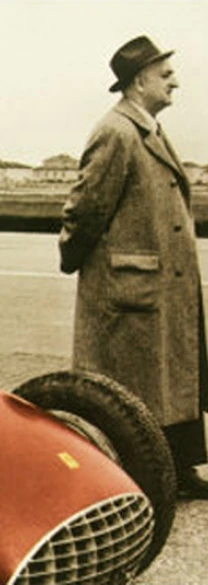
| |||
| Ferrari 250 | |||
|---|---|---|---|
| Ferrari | |||
| aka | 250 | ||
| Production | 1953-1964
" |
Class | Sports Car |
| Body Style | {{{Body Style}}} | ||
| Length | {{{Length}}} | ||
| Width | {{{Width}}} | ||
| Height | {{{Height}}} | ||
| Wheelbase | {{{Wheelbase}}} | ||
| Weight | {{{Weight}}} | ||
| Transmission | {{{Transmission}}} | ||
| Engine | {{{Engine}}} | ||
| Power | {{{Power}}} | ||
| Similar | {{{Similar}}} | ||
| Designer | {{{Designer}}} | ||
The Ferrari 250 is a series of sports cars from the 1950s and early 1960s. It was the company's most successful early line of vehicles, produced for over a decade from 1953 to 1964 and resulting in several variants. The 250 was replaced by the 275. The most celebrated 250 is the 1962 250 GTO, a true supercar that spawned numerous imitators.
Similarities[]
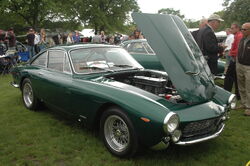
1963 Ferrari 250 GTL / Lusso
Most 250 road cars share the same two wheelbases, 2400 mm for short wheelbase (SWB) and 2600 mm for long wheelbase (LWB). Most convertibles used the SWB type.
Nearly all 250s share the same engine: The Colombo Type 125 V12. At 2963 cc, it is not a large engine even for the time, but its light weight and impressive output (up to 280 hp) made a big difference. The Ferrari V12 weighed hundreds of pounds less than its chief competitors — for example, it was nearly half the weight of the Jaguar XK straight-6. The light V12 propelled the small Ferrari 250 racing cars to victory after victory.
Racing models[]
Typical of Ferrari, the Colombo V12 made its debut on the race track, with the racing 250s preceding the street cars by three years.
225 S[]
A predecessor to the 250 line was the 225 S introduced at the 1952 Giro di Sicilia. Two of the two-seat sports
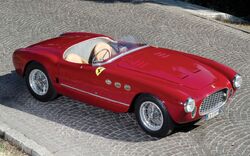
1952 Ferrari 225 S Spyder
prototypes were built, an open barchetta and closed coupe both by Vignale. Seven 225 S cars were entered at the Mille Miglia, but these were overshadowed by their larger-engined 250 S brother. Although not as heralded as the 250 line, the 225 did play one unique historical role: A 225 S tested at Imola was the first Ferrari to drive on that course.
The 225 effective replaced the 212 Export with a 2.7 V12 engine that enlarged the bore from 60 to 70mm. This was upgraded to use roller-type cam followers that were first introduced by Lampredi in the long-block V12. Power was rated at 210 bhp.
250 S[]
The first of the 250 line was the experimental 250 S Berlinetta prototype entered in the 1952 Mille Miglia. The company's newest product was entrusted to Giovanni Bracco and Alfonso Rolfo and was severely tested by the Mercedes-Benz 300SL racers run by Rudolf Caracciola, Hermann Lang, and Karl Kling. The little 230 hp (171 kW) Ferrari was outgunned in the long straights but fought back in the hills and curves and Bracco emerged victorious at the end. This same car was later entered at the 24 Hours of Le Mans and the Carrera Panamericana.
The little 250 S used a 2250 mm wheelbase with a "Tuboscocca" tubular trellis frame. Underneath were double wishbones at the front and a live axle located with double longitudinal semi-elliptic springs at the rear. Drum brakes and worm and sector steering were the norm. The dry-sump 3.0 L (2953 cc/180 in³) engine used three Weber 36DCF carburettors and was mated directly to a five-speed manual transmission.
250 MM[]
Lauding the success of the 250 S at the Mille Miglia, Ferrari showed a more-conventional chassis for the new 250 engine at the 1952 Paris Motor Show. Pinin Farina clothed this chassis, with the celebratory 250 MM coupe launched at the 1953 Geneva Motor Show. This car was almost plain by contemporary standards, but it possessed a certain purposefulness with its small grille and compact tail complete with a panoramic rear window. Carrozzeria Vignale's open barchetta also broke new styling ground, with recessed headlights and side vents becoming a staple of Ferrari design for the 1950s.
The 250 MM's wheelbase was longer than the 250 S at 2420 mm (95 in), with the saloon 50 kg (110 lb) heavier than the 850 kg (1875 lb) barchetta on a conventional tube frame. The V12 engine's dry sump was abandoned for the production car, and the transmission lost one cog as well, but power was up to 240 hp (179 kW).
Like the 250 S, the 250 MM was a racing car, debuting at the Giro di Sicilia with privateer Paulo Marzotto. A Carrozzeria Morelli-bodied 250 MM barchetta won the 1954 Mille Miglia with driver Clemente Biondetti, living up to its name. The V12-powered 250 MM was replaced by the four-cylinder 625 TF and 735 S later in 1953.
250 Monza[]
An unusual hybrid between the light four-cylinder 750 Monza and the 250 line was the 250 Monza of 1954. It used the short wheelbase chassis from the 750 Monza and the first two shared the Pinin Farina barchetta shape of the 750 Monza and a one-off 500 Mondial. Two more 250 Monzas were built by Carrozzeria Scaglietti, an early use of the now-familiar coachbuilder. Although a frequent entrant through 1956, the 250 Monzas failed to gain much success and the union of the Monza chassis and 250 engine was not pursued beyond this model.
The 250 Monza utilized the Columbo V12 engine which was nearly the same as the one found on the 250 MM. Each intake port was individual, not sharing the siamese-type setup of previous engines. This updated engine, combined with three 4-barrel Weber 36IF4C-1 carbs produced over 240 hp.
250 Testa Rossa[]
- See also Ferrari TR
The racing 250 Testa Rossa was one of the most successful Ferrari racing cars in its history.
250 GTO[]
- See also Ferrari 250 GTO
Perhaps the most famous 250 of all was the 250 GTO, often called the first supercar. A radically-restyled GTO, properly the 250 GTO/64, was launched in 1964, but just four were built.
250 P[]
- See also Ferrari P
The 250 engine from the Testa Rossa was mounted in the midships position for the 250 P prototype racer of 1963.
250 Le Mans[]
- See also Ferrari P
The mid-engined 250 Le Mans looked every bit the prototype racer but was intended to eventually be produced as a road-going GT. Descended from the 250 P, the Le Mans also appeared in 1963 and sported Pininfarina bodywork.
250 Export/Europa[]
The 1953 250 Export and Europa were the only of the family to use a different engine. They shared the 2963 cc Lampredi V12 designed for Formula 1 use.
250 Export[]
The Export model was similar to the 250MM with its 2400 mm wheelbase. One exception was its 220 hp (164 kW) Lampredi engine. It was launched at the Paris Motor Show of 1953.
250 Europa[]
The 250 Europa, also introduced in Paris in 1953, looked entirely different. With the long 2800 mm wheelbase and Ferrari America-style bodies, it was designed as more of a GT car than any previous 250. Both Pininfarina and Vignale handled the coachwork, with 21 produced in total.
Compared to the 212 Inter it replaced, the Europa was a much larger car, with a chassis like the 375 America and a much larger long block engine designed by Aurelio Lampredi. Only a handful of cars were built before a much more successful second series of cars were produced.
GT cars[]
The 250 design was extremely successful on the race course as well as the street. A number of GT models were built in varying states of road or racing trim.
250 Europa GT[]
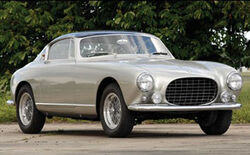
Bernie Ecclestone's 250 Europa GT Mk II.
The first street car to use Colombo's 250 V12 was the 250 Europa GT, introduced at the 1954 Paris Motor Show. Pinin Farina's sober Paris coupe was just one of many shapes for the 250 GT line, with coachbuilt production extending through 1956 before the 250 line became more of a standardized product. The original 250 Europa GT used a 2600 mm (102 in) wheelbase on a conventional chassis. The dry sump V12 was tuned to 220 hp (164 kW) with three Weber 36DCZ3 carburettors. Aping the Vignale's 250 Europa, Pinin Farina added now-familiar vents to the front fenders, a standard styling feature for many of the 250 GTs that followed.
250 GT Boano and Ellena[]
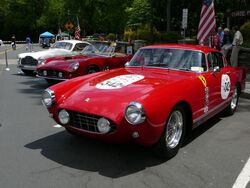
1958 California Spyder and 1959 GT Boano
Pinin Farina introduced a 250-based prototype at the 1956 Geneva Motor Show which came to be called the 250 GT Boano. Intended as a styling exercise and inspiration to 250 GT Europa customers, demand soon called for construction of a series of the car. Unable to meet demand, Pinin Farina asked Mario Boano, formerly of Ghia, to handle the construction. When Fiat recruited Boano, he handed production duties of the Ferrari to his son in law, Ezio Ellena. With partner, Luciano Pollo, Carrozzeria Ellena would produce the Ferrari for another few years. Ellena redesigned the car somewhat with a higher roof and removed the vent windows from the doors.
Carrozzeria Boano built 74 250 GTs on the long wheelbase chassis. All but one were coupes, with the single Convertible, 0461 GT, sold to New York collector, Bob Lee, off the stand at the 1956 New York Auto Show. Lee purchased the car for $9,500, far below cost, at the direction of Enzo Ferrari and owns the car to this day, making it one of the oldest Ferraris still in the hands of the original purchaser.
250 GT Berlinetta "Tour de France"[]
Named for the 10-day automobile race, not the famous bicycle race of the same name, a number of 250 GT "Tour de France" Berlinettas were sold for GT races from 1956 through 1959. Construction was handled by Carrozzeria Scaglietti based on a Pinin Farina design. The engine began at 240 hp (178 kW) but rose to 260 hp (193 kW) by the end.
A one-off short wheelbase Tour de France was built for the 1959 24 Hours of Le Mans. This car, called the 250 GT Interim, would foreshadow the 2400 mm (94 in) SWB cars of 1959.
250 GT Cabriolet[]
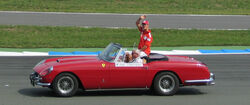
Michael Schumacher rides in a 250 GT Cabriolet
Released at Geneva in 1957, the original Pininfarina cabriolet used the 2600 mm wheelbase and had distinct bodywork from the Berlinetta. About 36 examples were produced before a second series was shown at Paris in 1959. These later cars had much more in common with the production Berlinetta. About 200 of the series two cars were built.
Motor Trend Classic named the 250 GT Series I Cabriolet and Coupe as number nine in their list of the ten "Greatest Ferraris of all time".
250 GT California Spyder LWB[]
Designed for export to America, the 1957 250 GT California Spyder was Scaglietti's interpretation of an open-top 250 GT. Aluminum was used in the hood, doors, and trunk lid, with steel specified elsewhere for most models, though a few aluminum-bodied racing versions were also built. The engine was the same as in the 250 Tour de France racing car with up to 240 hp (179 kW). All used the long 2600 mm chassis. About 45 were made before it was replaced by the SWB version in 1960, a fact mentioned by Ferris Bueller in the film that made the car famous. Today the car is worth in the neighborhood of 2-4 million dollars, a recent car selling for 1.2 million dollars at an RM Auction in Florida.
Since it appeared in the 1980's as Cameron's father's dream car in Ferris Bueller's Day Off, the Ferrari 250 GT California may be the most widely recognized of the various models produced.
250 GT Coupe[]
Desiring to enter series production in order to stabilize the company's finances, Enzo Ferrari asked Pinin Farina to design a simple and classic 250 GT coupe. The resulting car was introduced at Milan in 1958, and 335 nearly-identical cars were built by 1960. The GT Coupe eschewed the fender vents for simple and clean lines and a notchback look with a panoramic rear window. The oval grille was gone, replaced by a more traditional long narrow look with protruding headlights. Traditional telescoping shock absorbers were also fitted instead of the Houdailles found on previous 250s, and disc brakes were added in 1960. The final 250 GT Coupe had a Superfast tail and was shown at the 1961 London Motor Show.
250 GT Spider[]
In line with the high-volume coupe, Pinin Farina also designed a plainer 250 GT Spider for series production. Introduced at the 1959 Paris Motor Show, the GT Spider sported a look similar to the GT Coupe of the previous year, including the removal of the side vents. About 200 were produced.
250 GT Berlinetta SWB[]
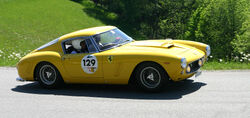
1961 250 GT Berlinetta SWB
One of the most important GT racers of its time, the 1959 250 GT Berlinetta SWB used a short (2400 mm) wheelbase for better handling. Of the 250 examples built, both steel and aluminum bodies were used in various road ("lusso") and racing trims. Engine output ranged from 240 hp (178 kW) to 280 hp (208 kW).
Development of the 250 GT SWB Berlinetta was handled by Giotto Bizzarrini, Carlo Chiti, and young Mauro Forghieri, the same team that later produced the 250 GTO. Disc brakes were a first in a Ferrari GT, and the combination of low weight, high power, and well-sorted suspension made it a competitive offering. It was unveiled at the Paris Motor Show in October and quickly began selling and racing. The SWB Berlinetta claimed GT class of the Constructor's Championship for Ferrari in 1961.
In 2004, Sports Car International named the 250 GT SWB number seven on the list of Top Sports Cars of the 1960s. Motor Trend Classic named the 250 SWB as number five in their list of the ten "Greatest Ferraris of all time".
On June 28, 2005, a pristine 250 SWB Berlinetta sold for €1,099,000 (US$1,328,000).
250 GT Spyder California SWB[]

1958 250 GT SWB California Spyder #2903 GT
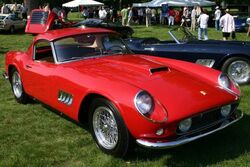
1961 Ferrari 250GT California Spyder
Replacing their LWB California Spyder with a SWB version, Scaglietti showed a new Spyder California at Geneva in 1960. Based on the 250 GT SWB, it also introduced disc brakes and a 280 hp (209 kW) version of the 250 V12. About 55 were built. A replica of the 250 GT Spyder California was featured as the untouchable car in the movie, Ferris Bueller's Day Off.
250 GT/E[]
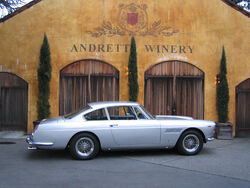
1963 Ferrari 250 GTE #4823 GT
The LWB 250 GT theme was expanded with the 2+2 model 250 GT/E. The first large production four-seat Ferrari (earlier four seaters were made in very small numbers). Interior space was increased by moving the engine forward in the chassis. The rear seats were ideal for children but rather tight for adults. Engine output was listed at 240 hp (178 kW).
954 GTEs were constructed by Pininfarina with prototypes starting in 1959 and continuing through three series until 1963. The model was followed by the visually similar 330 Americas. The large production run of the GT/E was a major contributor to the financial well being of Ferrari in the early 1960s. MSRP of the GT/E was $11,500.
250 GT Lusso[]
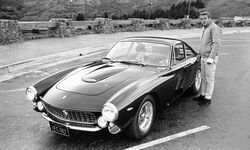
1963 250 GT Lusso Berlinetta (Steve McQueen)
Pinin Farina updated the 250 GT with the GT Lusso or GTL. Introduced at the 1962 Paris show, the car sported flowing lines and a fastback shape typical of the GT cars of the mid-1960s. Under the hood was the 250 GTO's Tipo 168 engine with 250 hp (186 kW) and three Weber 36DCS carburettors. Scaglietti handled construction of the Lusso which lasted through 1964 with few modifications.
In 2004, Sports Car International named the 250 GT Lusso number ten on the list of Top Sports Cars of the 1960s.
330 America[]
A 250 in all but name, the 1963 330 America shared the outgoing model's chassis if not its engine. Powered by the new 4.0 L engine of the later 330 cars, 50 330 Americas were built. Likely the most famous 330 America is that belonging to California socialite Sandra Ilene West. Mrs. West was buried at the wheel of her car following a 1977 drug overdose. Her instructions specified that she be clad in her lace nightgown with the driver’s seat "slanted at a comfortable angle". The car (and driver) is interred at the Alamo Masonic Cemetery, San Antonio, Texas.
Trivia[]
- A replica Ferrari 250 California Spyder was used in the 1986 film Ferris Bueller's Day Off. It was Cameron Frye's dad's car.
Photos[]
See Also[]
| Ferrari road car timeline, 1947–1967 ([edit]) | later-> | |||||||||||||||||||||
| Type | 1940s | 1950s | 1960s | |||||||||||||||||||
| 7 | 8 | 9 | 0 | 1 | 2 | 3 | 4 | 5 | 6 | 7 | 8 | 9 | 0 | 1 | 2 | 3 | 4 | 5 | 6 | 7 | 8 | |
| sports | 125 | 166 | 195 | 250 S/MM |
250 Export |
250 GT Tour de France |
250 GT SWB |
250 GTO | ||||||||||||||
| 159 | 212 | 250 GT Cabriolet |
250 GT Spyder California | |||||||||||||||||||
| GT | 250 Europa |
250 GT Europa |
250 GT Boano |
250 GT Ellena |
250 GT Pininfarina |
250 GT Lusso |
275 GTB | 275 GTB/4 | ||||||||||||||
| 2+2 | 250 GT 2+2/GTE |
330 GT | 365 GT | |||||||||||||||||||
| America | 340 America |
375 America |
410 Superamerica |
400 Superamerica |
500 Superfast |
365 California |
||||||||||||||||


